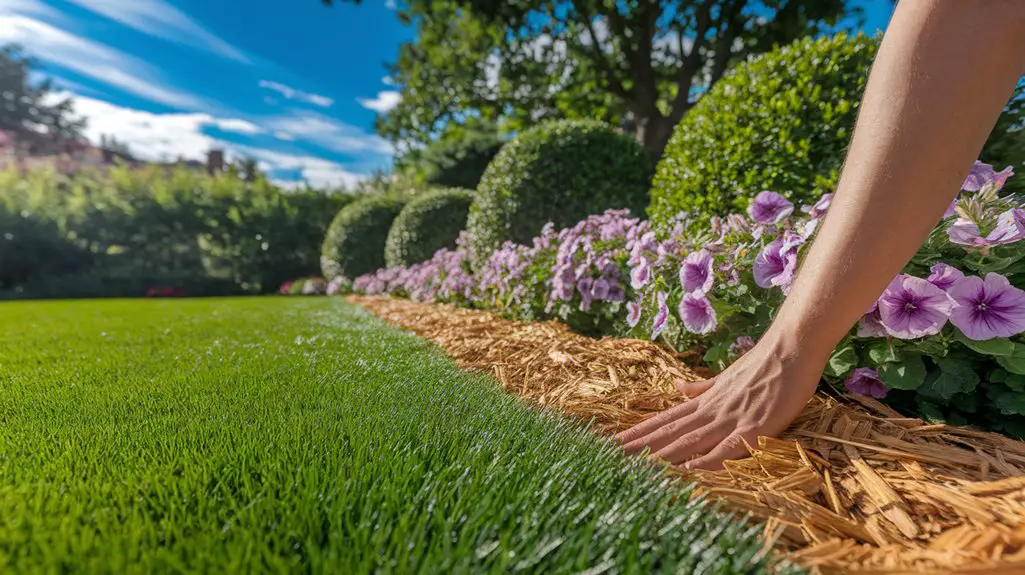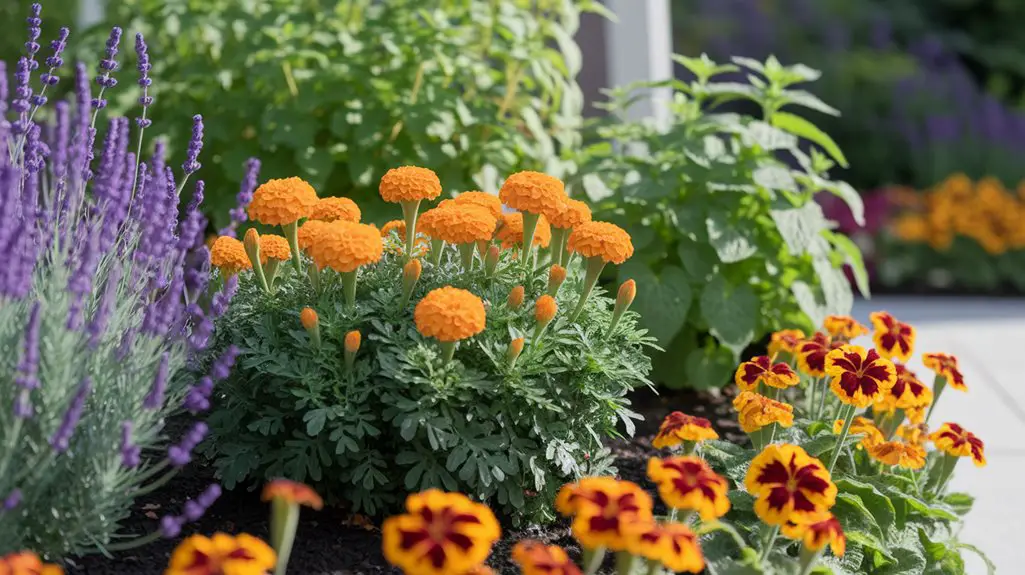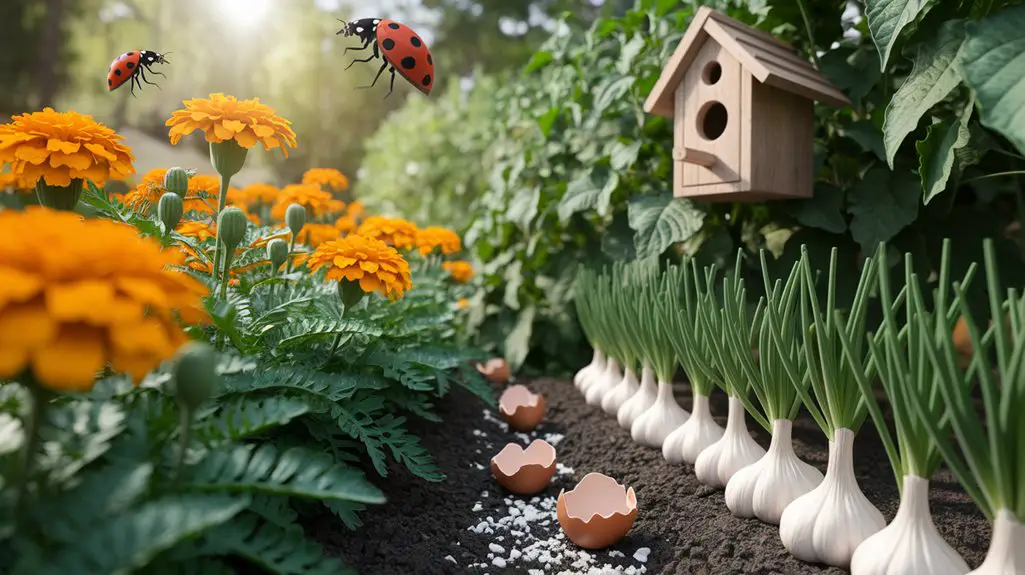You’ll prepare in spring, water in summer, aerate in fall, and protect in winter to maintain your lawn’s vigor throughout the year. Following seasonal care patterns guarantees your turfgrass develops robust root systems, maximizing drought resistance and nutrient uptake efficiency. Your soil structure benefits greatly from proper pH management (ideally 6.0-7.0) and organic matter integration. The difference between a struggling lawn and a thriving one often lies in these crucial seasonal changes that most homeowners overlook.
Spring Soil Preparation and Seeding Techniques
As winter’s grip loosens and soil temperatures consistently reach 50°F, you’ll need to begin proper spring soil preparation to maximize lawn growth potential.
Start by conducting a soil pH test, aiming for the 6.0-7.0 range that most turfgrasses prefer. Apply lime to raise pH or sulfur to lower it as indicated.
Core aeration should be performed when soil is moist but not saturated, removing 2-3 inch plugs at 3-inch intervals. This alleviates compaction and enhances nutrient penetration.
For overseeding, select cultivars matched to your microclimate—Kentucky bluegrass for full sun, fine fescues for shade. Apply seed at 3-4 pounds per 1,000 square feet for new lawns, 1-2 pounds for overseeding.
Cover with ¼ inch of compost, then water lightly twice daily until germination occurs. Additionally, consider using raised garden beds to improve soil drainage and create a more manageable growing environment.
Summer Watering Strategies for Healthy Lawns
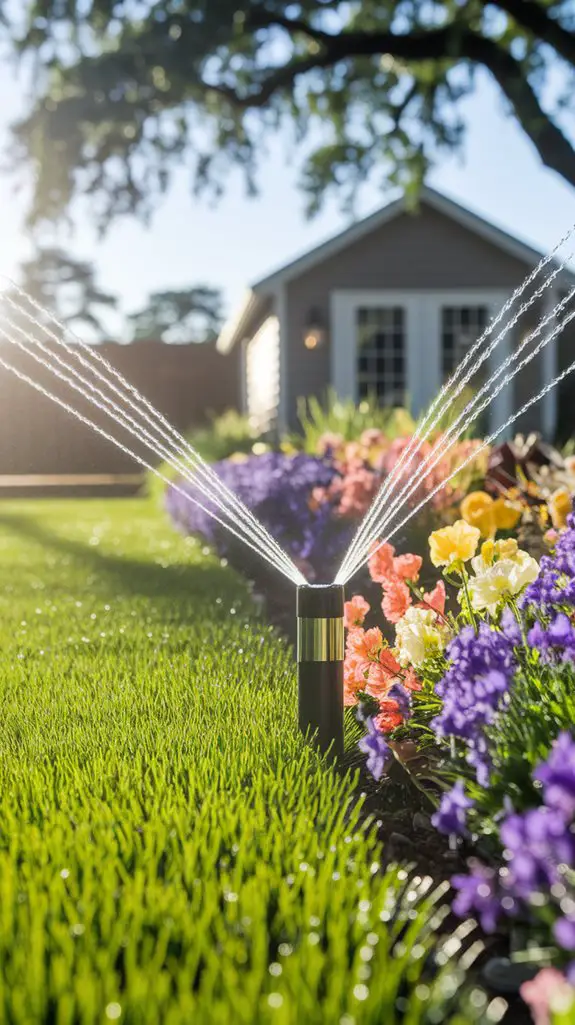
Summer brings heightened evapotranspiration rates that directly challenge your spring seeding efforts.
You’ll need to implement strategic irrigation protocols to maintain ideal soil moisture levels of 1-2 inches per week. Water deeply (6-8 inches) rather than frequently to encourage downward root growth that enhances drought resistance in your turfgrass varieties.
- Apply water during pre-dawn hours (4:00-6:00 am) when wind velocity is minimal and hydraulic pressure in municipal systems peaks.
- Adjust irrigation duration based on soil type: sandy soils require 0.5″ every third day; clay soils need 0.75″ twice weekly.
- Implement cycle-soak technique for sloped areas by dividing watering time into 10-minute intervals with 30-minute pauses to prevent runoff.
Monitor for hydrophobic soil conditions and apply surfactants if water beads rather than penetrates the thatch layer. Additionally, consider incorporating seasonal lawn care practices to enhance the overall health of your vegetable garden.
Fall Aeration and Overseeding Benefits
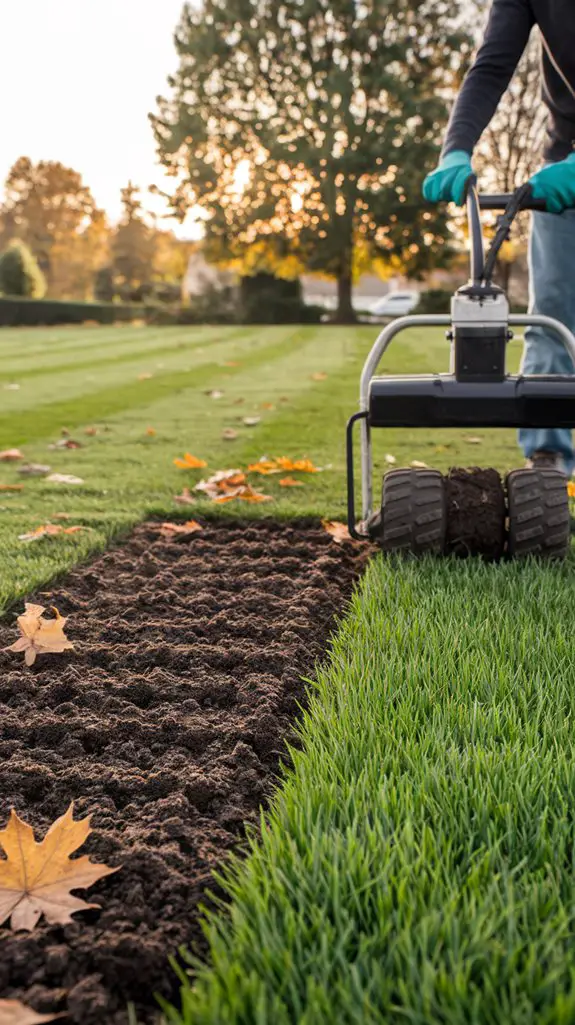
Fall presents the ideal window for core aeration and overseeding procedures when soil temperatures consistently range between 50-65°F (10-18°C).
During this period, root development accelerates while weed competition decreases, maximizing seed-to-soil contact for peak germination rates.
Core aeration removes 2-3 inch soil plugs, alleviating compaction and allowing oxygen, water, and nutrients to penetrate the root zone.
This process reduces thatch accumulation beyond the beneficial ¼-inch threshold and stimulates beneficial microbial activity.
When overseeding, select cultivars with high disease resistance and drought tolerance.
Kentucky bluegrass requires 21-28 days for germination, while perennial ryegrass establishes in just 5-10 days.
Apply seed at species-appropriate rates: 2-3 lbs/1000ft² for bluegrass and 6-8 lbs/1000ft² for tall fescue varieties.
Winter Protection Methods for Dormant Grass
Once your lawn enters dormancy when soil temperatures drop consistently below 45°F (7°C), implementing specific winter protection strategies becomes essential for preventing crown hydration injury, desiccation damage, and snow mold development.
Winter dormancy doesn’t equal invulnerability—your turfgrass remains susceptible to environmental stressors during this metabolically inactive period.
- Apply a late-fall nitrogen application (0.5-1.0 lb N/1000 ft²) using a slow-release formulation to improve cold hardiness without stimulating late-season vegetative growth that increases frost susceptibility.
- Maintain 2.5-3.5 inch mowing height on cool-season grasses (Kentucky bluegrass, perennial ryegrass) to provide insulative properties while avoiding matting that creates microclimates favorable for Microdochium nivale infection.
- Consider protective barriers like permeable anti-desiccation spray or lightweight row covers for exposed areas subject to prevailing winds that accelerate moisture loss from crown tissue.
Additionally, implementing eco-friendly lawn care practices can enhance the resilience of your grass against winter stressors.
Natural Pest Management Throughout the Year
While effective lawn care necessitates addressing pest concerns, implementing natural management strategies throughout the seasonal cycle provides sustainable control without compromising ecosystem health or beneficial soil micro. Utilizing organic pest control methods can further enhance the effectiveness of your natural pest management approach.
Organic Fertilization Schedule by Season
Implementing a season-specific organic fertilization regimen allows you to synchronize nutrient delivery with your lawn’s natural growth cycles.
Apply nitrogen-rich compost tea (10:1:1 NPK ratio) in spring when soil temperatures reach 55°F, supporting chlorophyll production during vigorous vegetative growth.
Shift to phosphorus-enhanced bone meal applications (5:10:5) during summer to strengthen root systems against drought stress.
Fall applications should feature potassium-dominant amendments (3:1:10) to enhance cold hardiness by increasing cell wall thickness and osmotic regulation.
Incorporate mycorrhizal fungi inoculants during mid-spring and early fall to maximize nutrient uptake efficiency.
Maintain a soil pH between 6.2-7.0 using dolomitic lime or elemental sulfur to optimize micronutrient availability throughout all fertilization cycles.
Additionally, consider effective mulching techniques to conserve moisture and suppress weeds, complementing your fertilization efforts throughout the growing seasons.
Proper Mowing Heights for Different Seasons
Adjusting mowing heights seasonally complements your organic fertilization program by optimizing grass blade photosynthetic capacity and stress tolerance.
In spring, set your mower at 2.5-3 inches for cool-season grasses (fescue, Kentucky bluegrass) and 1.5-2 inches for warm-season varieties (Bermuda, zoysia). This encourages robust root development.
Summer demands raising heights by 0.5-1 inch to increase shade at soil level, reducing evaporation and weed germination. Taller grass maintains soil moisture and mitigates heat stress.
For fall, gradually reduce cool-season grass height to 2-2.5 inches to prevent matting under snow and minimize fungal disease pressure. Warm-season grasses should maintain summer height until dormancy.
Winter mowing should cease for dormant warm-season varieties, while cool-season grasses benefit from occasional 2-inch cuts during growth periods.
Weed Control Approaches for Each Season
Effective weed control strategies shift dramatically with each season, requiring targeted approaches based on weed life cycles and growth patterns.
You’ll maximize efficacy by applying pre-emergent herbicides in early spring (soil temperature 55°F) to inhibit crabgrass germination, while targeting broadleaf perennials with selective post-emergents during fall when they’re translocating nutrients to root systems.
- Spring: Apply corn gluten meal as organic pre-emergent (contains 10% nitrogen); monitor soil temperature with probe thermometer for precise timing.
- Summer: Spot-treat with targeted herbicides containing triclopyr for creeping charlie; minimize broad applications during dormancy periods.
- Fall: Utilize systemic herbicides containing 2,4-D and dicamba when temperatures range 50-75°F for maximum translocation into perennial root structures.
Winter dormancy offers ideal timing for planning thorough control strategies based on previous season’s weed pressure documentation. Additionally, understanding weed life cycles can greatly enhance your effectiveness in implementing these seasonal strategies.
Equipment Maintenance for Year-Round Lawn Care
Proper maintenance of lawn care equipment throughout the year not only extends the operational lifespan of your tools but also assures peak performance during critical growth periods.
Sharpen mower blades bi-monthly during growing seasons to ensure clean cuts that minimize Festuca and Poa species trauma. Clean air filters after every 25 hours of operation, replacing when saturated with particulate matter.
Winterize gas-powered equipment by draining fuel or adding stabilizer to prevent carburetor varnishing. Apply lubricant to pivot points on manual shears and pruners, using silicone-based products that won’t attract debris.
For battery-powered tools, store lithium-ion batteries at 40-80% charge capacity in temperature-controlled environments (40-70°F) to prevent cell degradation. Additionally, maintaining raised garden beds can enhance soil health, which in turn supports overall garden vitality.
Inspect irrigation equipment for calcification in November, removing mineral deposits with vinegar solutions before spring activation.
Conclusion
Synchronize your lawn care regimen precisely with seasonal flux to witness transformative results. You’ve now acquired the complete Poaceae management protocol—but will you implement it? The rhizosphere awaits your attention; soil microbiota populations hang in balance. Remember: turfgrass resilience depends on your timing of nitrogen application rates, irrigation frequency calibration, and thatch management. Don’t wait—your Festuca or Cynodon stand requires immediate seasonal adaptation for peak photosynthetic capacity.

